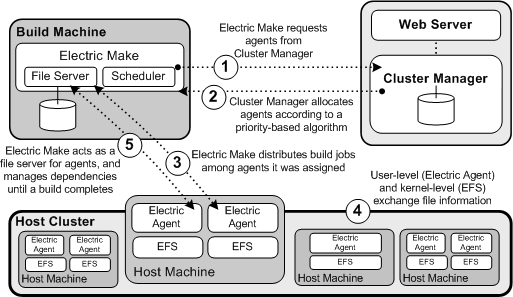To a user, Accelerator might appear identical to other Make versions—reading makefiles in several different formats and producing identical results. Using a cluster for builds is transparent to the Accelerator user.
Following are some important differences in Accelerator build processing versus other distributed systems:
-
Accelerator components work together to achieve faster, more efficient builds. Instead of running a sequential build on a single processor, Accelerator executes build steps in parallel on a cluster of hosts.
-
ElectricAccelerator Developer Edition components work together to achieve faster, more efficient builds. Instead of running a sequential build on a single processor, ElectricAccelerator Developer Edition executes build steps in parallel using multiple local agents.
-
For fault tolerance, job results are isolated until the job completes. If an agent fails during a job, Accelerator discards any partial results it might have produced and reruns the job on a different agent.
-
Missing dependencies discovered at runtime are collected in a history file that updates each time a build is invoked. Accelerator uses this collected data to improve performance of subsequent builds.
eMake and EFS
EFS enables high concurrency levels in Accelerator . When a job such as a compilation runs on a host, it accesses files such as source files and headers through EFS. EFS records detailed file-access data for the build and returns that data to eMake.
eMake acts as a file server for agents by dynamically virtualizing the host file system to cluster nodes while the build is running. The agent relays file data from eMake into the kernel, then notifies EFS, which then completes the original request. At the end of a job, the agent returns any file modifications to eMake, so that it can apply changes to its local file systems.
